Equity markets get their groove back as Fab Four step into line
Equity markets are showing sustained signs of normality after the rollercoaster ride of last year, says Epoch Investment Partners managing director John Tobin.
The so-called Fab Four stocks — Apple, Microsoft, Amazon, and Tesla — drove the rebound from the bottom of the trough reached on 23 March, Tobin says.
At one stage, those four accounted for about half the return generated by the MSCI World Index, which covers 1,500 companies.
Tobin, who is also a portfolio manager and senior research analyst at Epoch in New York, conducted a webinar recently for GSFM Funds Management.
He demonstrates how the fundamental measures of company performance — earnings growth and dividend yields — still drive long-term returns in equities, despite the massive swings in price/earnings multiples of recent memory.
Tobin says the performance of Epoch's Global Equity Shareholder Yield Fund throughout 2020 and 2021 vindicates its strategy of protecting against downside loss while allowing for upside benefits.
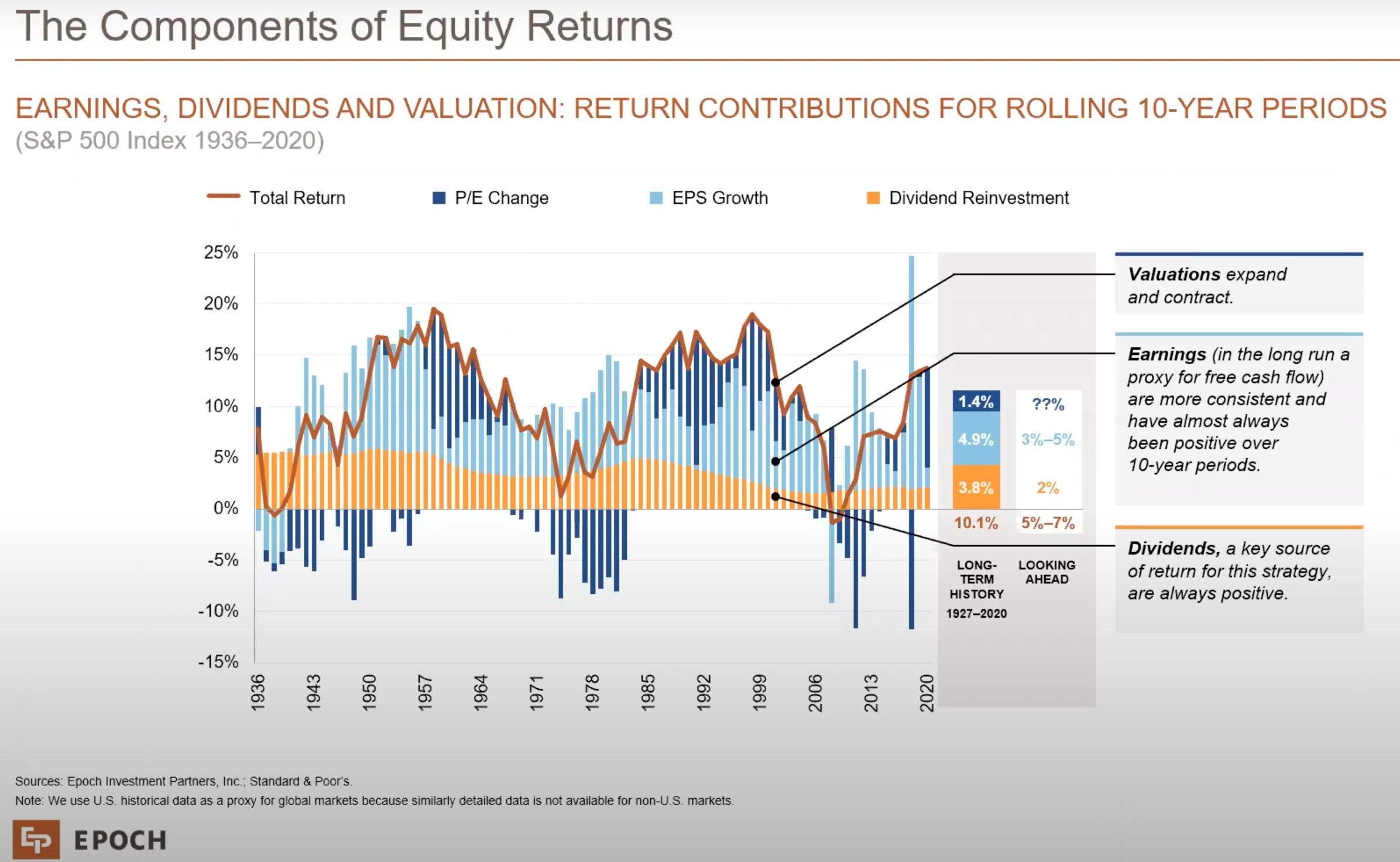
History shows where returns come from
Tobin describes the above chart as foundational in Epoch's investment philosophy.
"We're looking at the Standard & Poor's 500 Index going all the way back to 1936," he says. "We've taken the total return and we've broken it down into three component parts.
"How much of the return is due to changes in price/earnings multiples, how much of the return is due to earnings growth and how much is due to dividends?"
Tobin acknowledges that price/earnings multiples can drive returns in any given period, but the longer the timeframe, the less they affect total returns. "What you're left with is earnings growth and dividends as the fundamental drivers of long-term equity returns."
The bar chart on the right shows how the S&P 500 has returned about 10% per year. Of that, 3.8% comes from dividends, 4.9% from earnings and only 1.4% from expansion or contraction in price/earnings multiples.
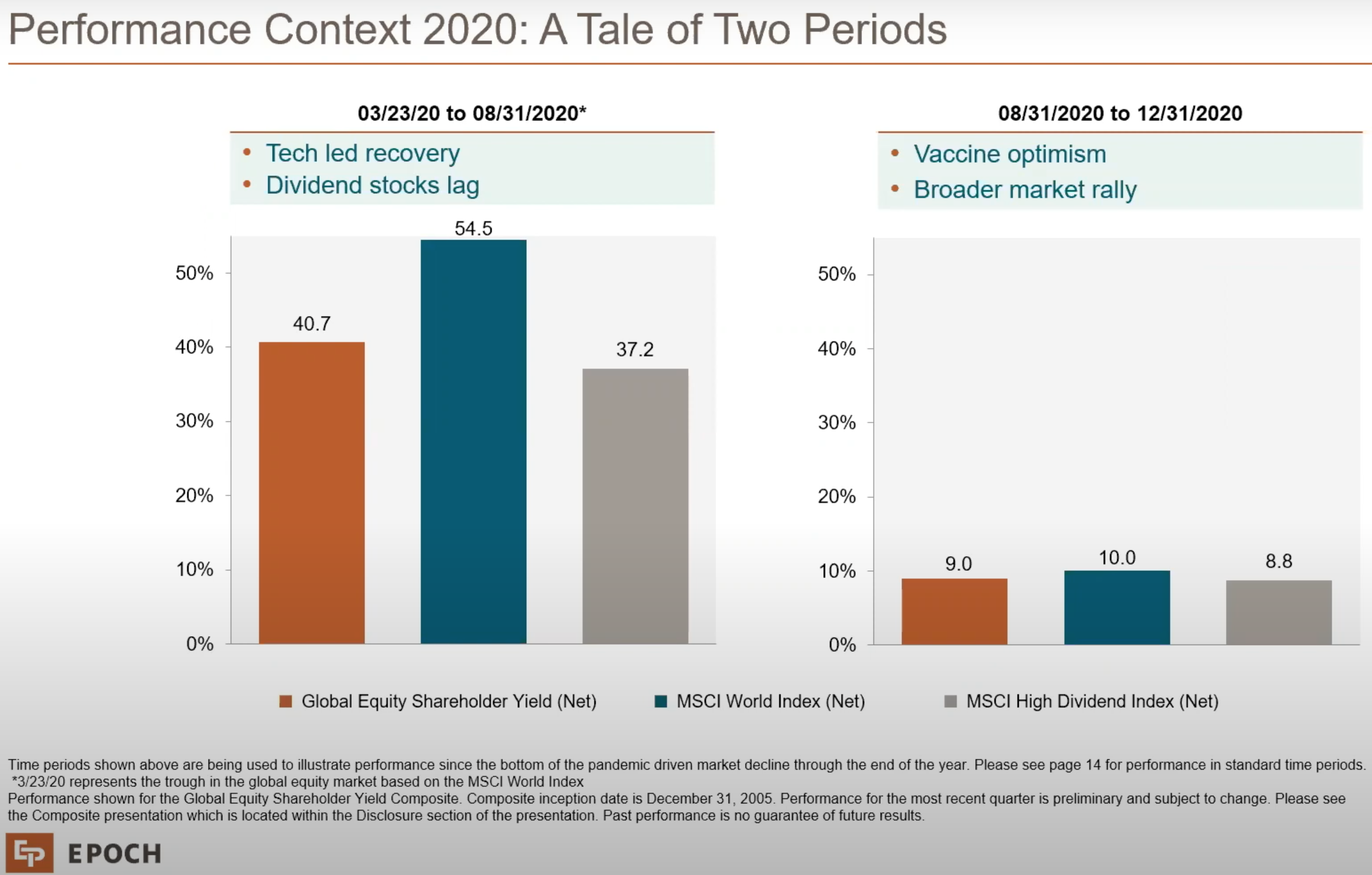
Growth stocks took the lead
Tobin depicts 2020 as a challenging year for investors seeking dividends, income, or value. "There were significant headwinds for those kinds of strategies — the market was very focused on momentum and growth," he says.
As the above chart shows, 2020 was a tale of two periods: 23 March to 31 August, and 31 August to 31 December.
The first period began with the bottom of the market. "You can point to that date and say that's exactly when it turned," Tobin says. "In roughly five months, the MSCI World Index in US dollar terms rose 55%. That's extraordinary."
The right side of the chart shows the second period. Optimism kicked in as vaccinations began to look likely. Then came news of actual vaccines from Pfizer and Moderna, which triggered the reopening.
"The leadership of the market was no longer so narrowly defined," Tobin says. "In the latter half of the year, it was a much more competitive horse race."
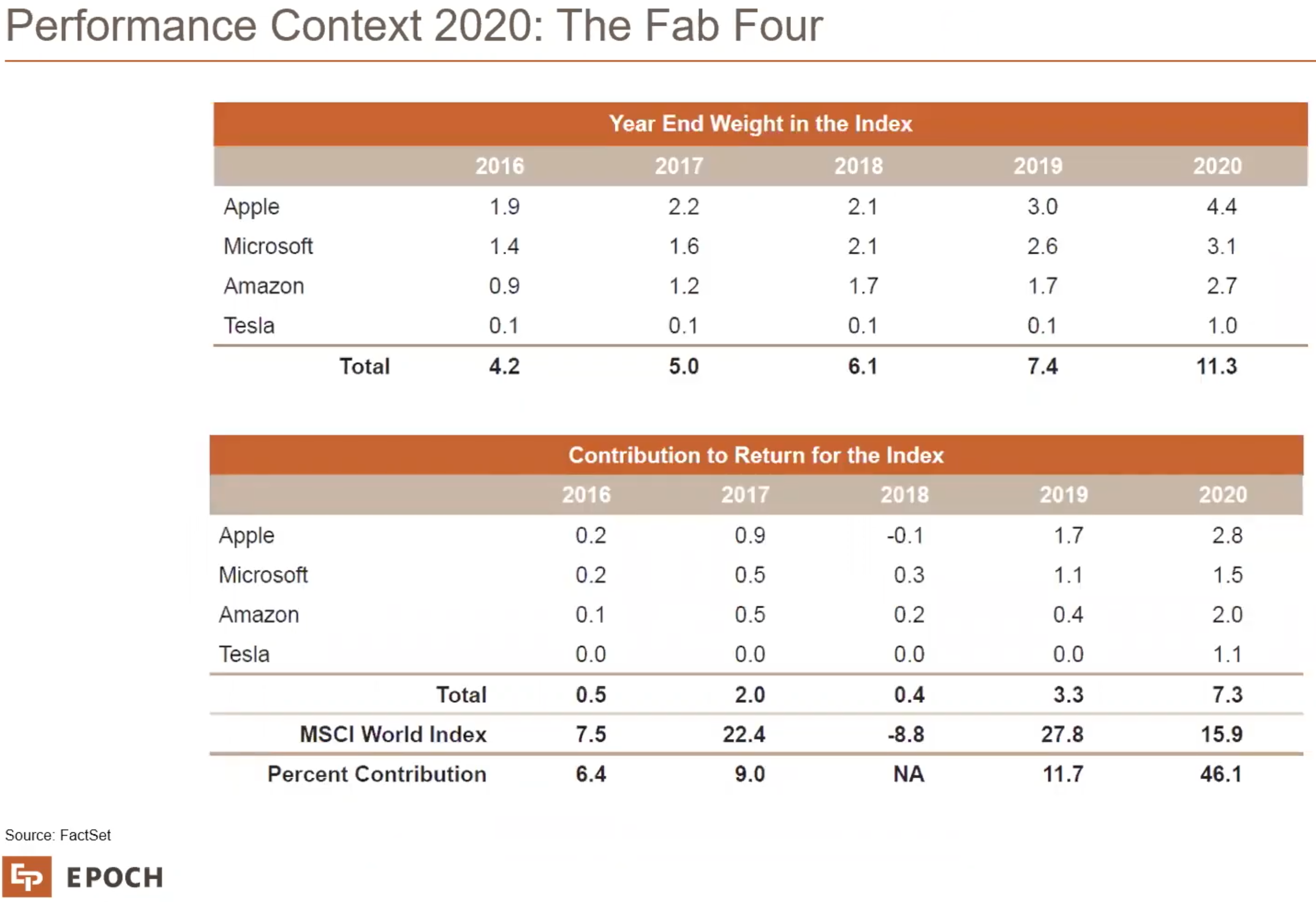
For a while, it was all about tech
Tobin uses the above table to show how much equity markets rewarded growth stories.
"We're looking at four stocks: Apple, Microsoft, Amazon, and Tesla," Tobin says. "All four of them together, in 2016, represented 4.2% of the index. And you can see how they were growing in relative importance."
The lower part of the table shows how those four companies contributed to returns in the same intervals.
"If you look at 2016, for example, those four stocks together generated a return of 0.5%. And the MSCI World Index that year was up 7.5%. So those four stocks accounted for a little over 6% of the return in 2016.
"Fast forward to 2020. Those four stocks accounted for 46% of the return that was generated by the MSCI World Index in 2020. This is an index that has 1500 stocks. And in 2020, those four accounted for almost half the return that was generated."
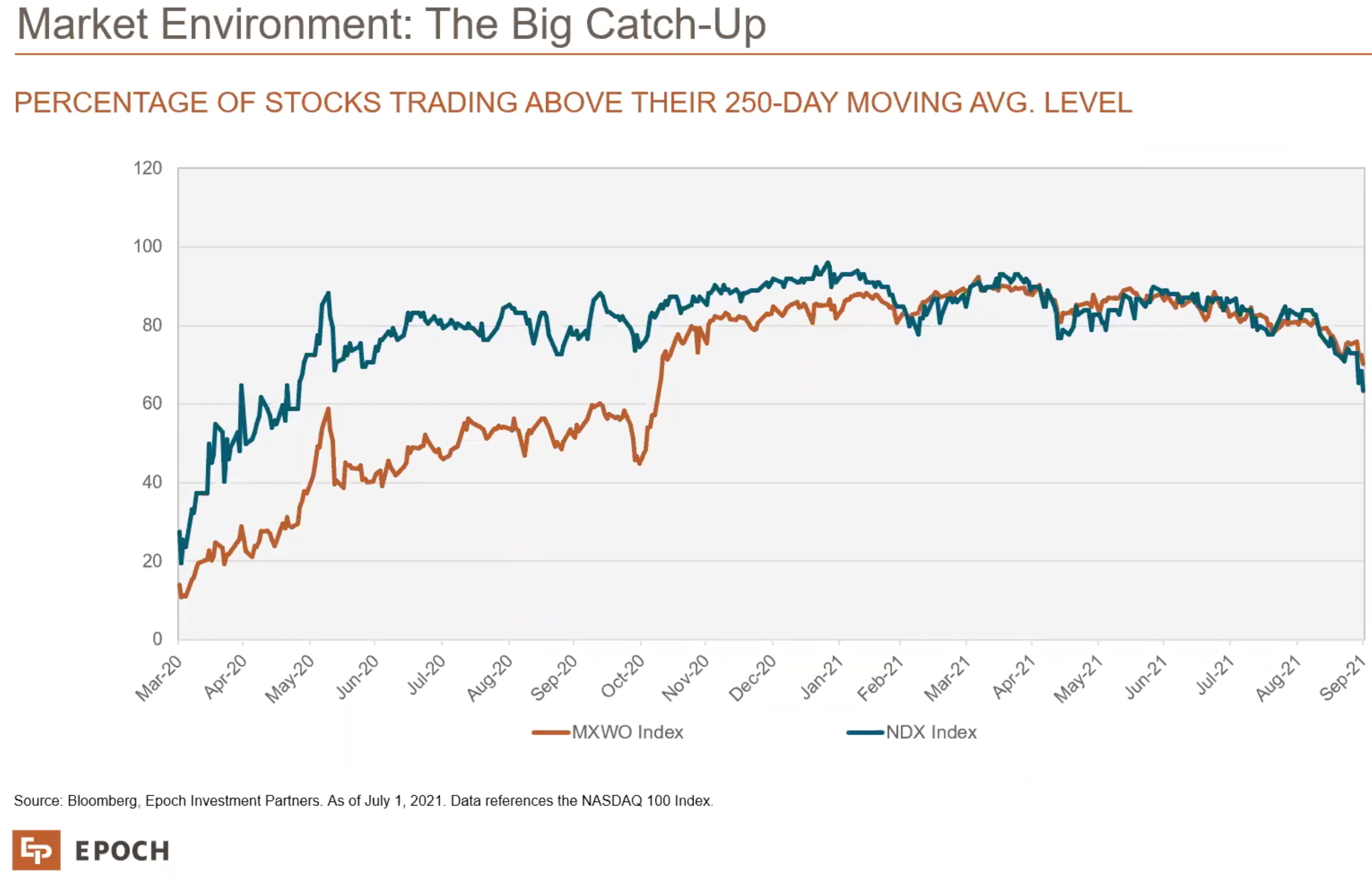
Closing the gap
The above chart shows two time series: the MSCI World Index and the NASDAQ 100.
"We're looking at the percentage of stocks in each of those indexes trading above their 250 day moving-average level," Tobin says.
"In June 2020, about 40% of the MSCI World stocks were trading above their 250 day moving average, while about 70% of the NASDAQ stocks were trading above their 250 day moving average."
In other words, mega cap tech and e-commerce stocks led the snapback rally, and the rest of the world was left behind. Then came the big catch-up.
"As soon as we got news in November about the successful vaccines, that was a game changer. For the remainder of 2020 and the entirety of 2021 so far, these two lines are trading right on top of each other. The environment for a year now has been much more normal."
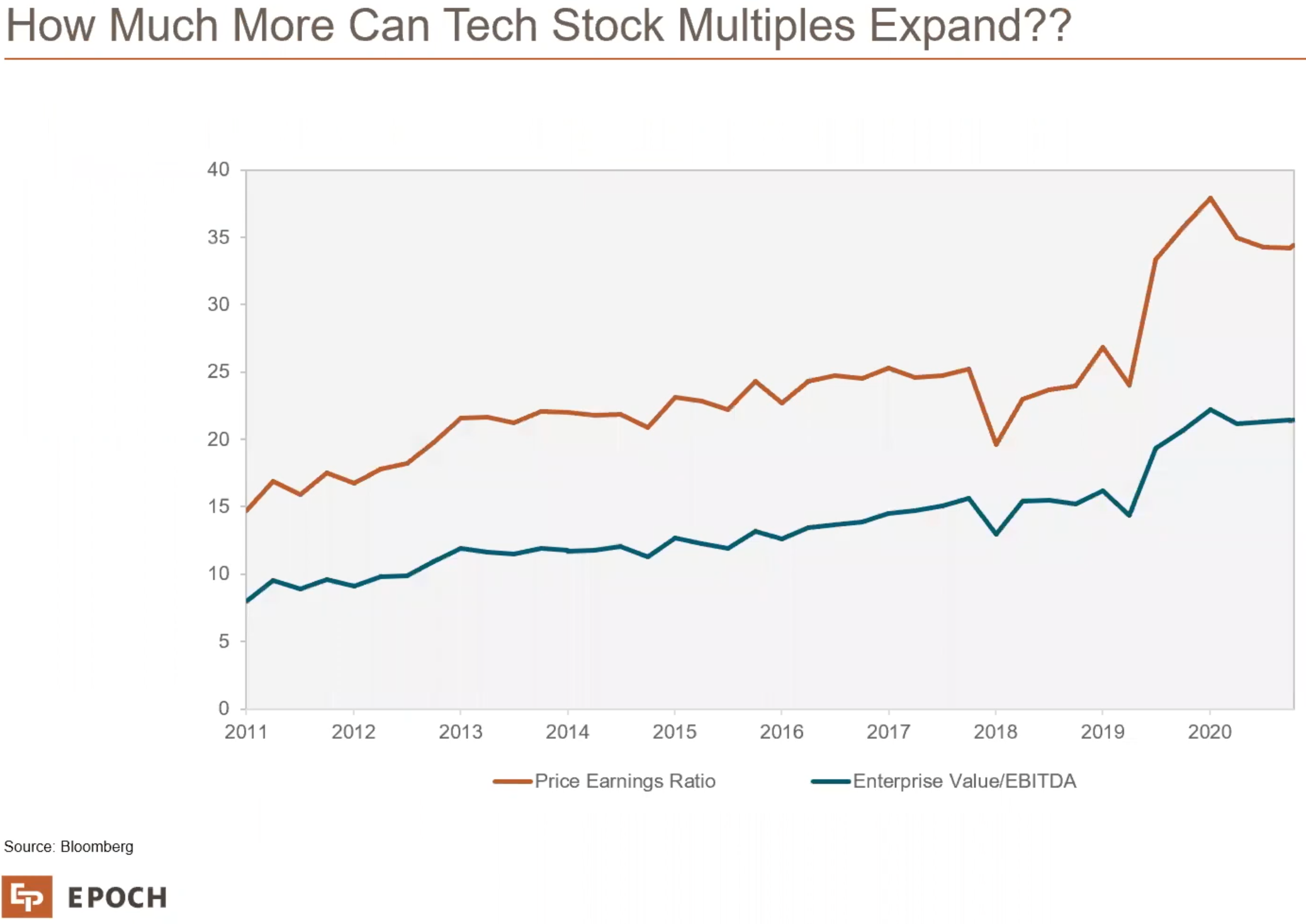
Tech looks toppy
"We have to ask the question, how much more can tech-stock multiples expand?" Tobin says.
The chart above compares price/earnings ratios with enterprise value/EBITDA ratios for NASDAQ 100 companies.
"You can see that over the period of 10 years, there's a pretty significant and dramatic increase in both of those multiples, starting at about the end of 2019 and going into 2020," Tobin says.
Given long-term equity returns are driven by earnings and dividends, Tobin says investors ought to be considering their exposure to tech stocks. "Another way of phrasing it is: what's the risk in my portfolio?"
Slower growth is still growth
Turning to macro considerations, Tobin sees global economies continuing to reopen. "Granted, this is happening unevenly; it's not a smooth, straight line," he says.
"I would put on my economist hat and point out to you that even as growth rates are slowing around the world, these economic growth rates are well above trend.
"If the United States economy slows down next year and grows at a GDP rate of over 4% or even 3.5 percent, that is significantly above the long term trend growth, which is maybe 2.5 percent per year.
"What we're talking about when we talk about slowing growth, we're talking about growth decelerating. We're talking about growth rates that are returning over time to trend growth rates."
Higher interest rates are looming
On central bank policies, Tobin predicts any adjustments will be cautious.
"There's certainly talk in the United States about the Fed potentially starting to taper the quantitative easing programme as soon as next month," he says.
"Keep in mind that even as this starts to happen, what we're talking about is central banks slowing the pace at which they are actively buying bonds by the many, many billions in the marketplace. That process is likely to continue in the United States until at least the mid point of 2022."
"Other central banks, similarly, will be moving very gradually and very cautiously to reduce accommodation.
"Interest rates from the central banks are probably not going to start rising until the latter part of 2022, and when they do, we expect that also to be done at a cautious and gradual pace."
Inflation is settling in
Tobin acknowledges inflation pressures, even if transitory, are a concern.
"We all read about the supply-chain issues that are causing spikes in commodity prices, freight prices, transportation costs. We're seeing it in labour costs.
"It's quite likely that some of these trends and transitory inflation pressures, some of them are probably not going to be transitory. Some of them are going to be with us for a little while. And if you thought transitory meant three to six months, that's probably not what transitory really means."
"And that then leads to an environment where it is likely that interest rates are going modestly higher, not lower.
"In a global economy that's expanding and recovering, where there are some inflationary pressures, it makes sense that the general trajectory of interest rates should be gradually and modestly higher."
Dreaming of profits won't cut it
Tobin has a warning regarding companies whose valuations rely on forecasts rather than actual cash flows.
"Even a modestly higher interest rate environment creates a headwind for what we today are referring to as the long-duration equities, those companies where the cash flows — to the extent that they can be foreseen — are going to occur years into the future."
"As we look ahead, we think that this brightening economic outlook is a good thing. It's a positive for earnings and cash flows.
"We're going through earnings season right now. We're seeing companies report stronger earnings, stronger revenues, stronger cash flows, raising dividends and engaging in share-purchase programs.
"We also see a market that is more broadly driven rather than one that's narrowly focused on a small handful of tech stocks.
"So broad participation across sectors, across industries and across geographies — we think that is a much healthier environment."
To view John Tobin's webinar, click here.

Never miss an insight
Enjoy this wire? Hit the ‘like’ button to let us know. Stay up to date with my content by hitting the ‘follow’ button below and you’ll be notified every time I post a wire.
Not already a Livewire member? Sign up today to get free access to investment ideas and strategies from Australia’s leading investors.
5 topics
1 fund mentioned
1 contributor mentioned

